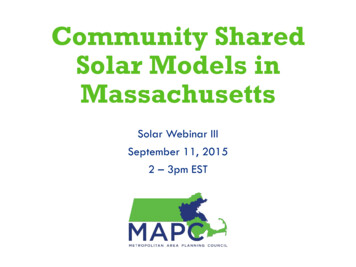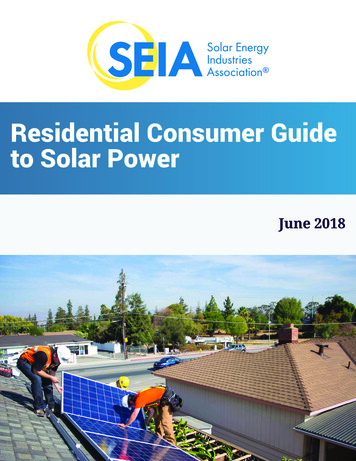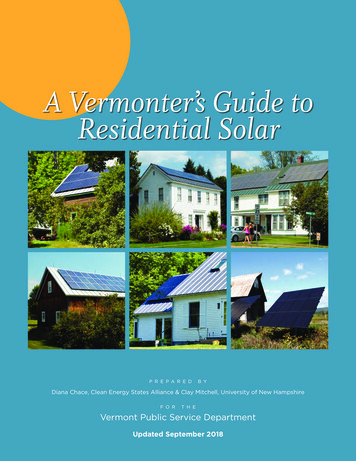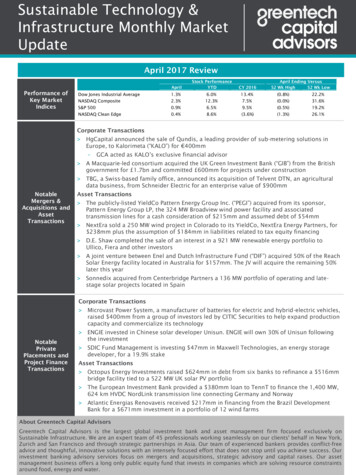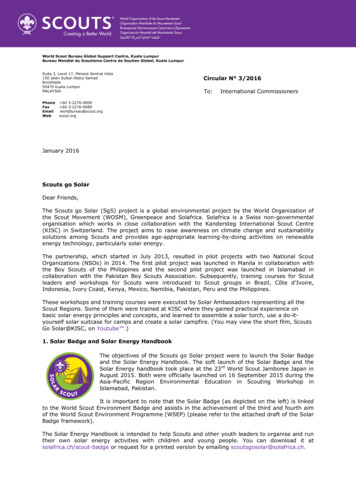
Transcription
MASSACHUSETTSRESIDENTIAL GUIDETO SOLAR POWER
Front cover photo: Elena Elisseeva/Bigstock
Flickr.com/mjmontyTable of ContentsIntroduction1Solar PV System Components3Sizing and Optimizing Your Solar PV System5Important Regulations8Economics of Solar PV10Environmental Benefits of Solar PV13How to Go Solar14Homeowner’s Solar PV Checklist17
INTRODUCTIONFlickr.com/EarthwormIntroductionSolar Electricity TodaySolar photovoltaics (solar PV) systems convert sunlight into electrical energy through an array of solarpanels that connect to a building’s electrical systemand/or the electrical grid.Massachusetts initiated its first incentive programfor solar PV in 2001, funded through a small renewable energy charge on most electric utility bills.In April 2007, solar PV took off in Massachusettswhen Governor Deval L. Patrick announced a goalof having 250 MW of installed solar power by 2017.To begin reaching this goal, which was significantlyhigher than the 3.5 MW of solar PV installed at thetime, the state launched the Commonwealth SolarRebate Program in January 2008. Since the startof this innovative program, thousands of solar PVprojects have been installed throughout the state,providing clean, renewable energy to ratepayers ofthe Commonwealth. Massachusetts is known as anational-leader in solar with one of the best regulatory and incentive climates for solar energy. Since2007, the number of solar installers in Massachu-Massachusetts Residential Guide To Solar Powersetts has grown from dozens to hundreds, and theMassachusetts solar market has enticed numerousbusinesses that make solar energy financially accessible for more people in the Commonwealth.Residents who have already installed solar PV systemscite many different reasons for going solar, including: Electricity cost savings and price stability; Concern about pollution, the environment, andclimate change; and Desire for energy independence and increasedcontrol over energy choices.For many residents and business owners throughout Massachusetts, installing a solar PV system isa smart investment that converts clean, free sunlight to electricity, reduces air pollution, reduces oreliminates monthly electricity bills, and contributesto the local economy by creating local jobs and supporting local businesses.1
About this GuideAdditional ResourcesThe aim of this guide is to assist Massachusetts residents who are considering using solar energy to generate electricity to power their homes. This guide canhelp you determine whether solar PV is right for youboth technically and economically. It reviews the installation process and provides advice and resourceson finding an installer and securing rebates, as wellas other pertinent information about solar PV. Thisguide focuses on grid-connected solar PV systems;however, the use of solar PV for off-grid electricitygeneration can be cost effective in remote locationswhere it is impractical or uneconomical to connectto the electric grid.Visit www.MassCEC.com and www.MassCEC.com/AboutSolar for additional resources and informationregarding solar PV and other clean energy technologies targeted at a broad range of clean energy consumers, producers, and stakeholders.While this guide is intended primarily for homeowners, many of the issues discussed apply to small-scaleinstallations in general and may apply to businessesconsidering installing solar PV.of the regulations and incentivesWW Somediscussed in this guide may not apply tocertain customers of Municipal Light Plants(MLPs). Customers of MLPs should contactthe MLP to determine whether they payinto MassCEC’s Renewable Energy TrustAbout MassCECCreated by the Green Jobs Act of 2008, theMassachusetts Clean Energy Center (MassCEC)is dedicated to accelerating the success of cleanenergy technologies, companies and projects in theCommonwealth—while creating high-quality jobsand long-term economic growth for the people ofMassachusetts. MassCEC is a partner, clearinghouseand connector for people in the clean energysector, making direct investments in clean energycompanies, building a strong clean energy workforce,and supporting responsibly sited renewable energyprojects across the Commonwealth. MassCECworks with the entire clean energy community inMassachusetts to propel promising technologiesfrom the drawing board to the global marketplace.For more information visit: www.MassCEC.com.(a prerequisite for receiving rebates fromMassCEC’s programs), whether the MLPallows for net metering and interconnection,and whether there are any incentives orrequirements in addition to or in place ofthose described in this guide.The Massachusetts Clean Energy Center has developed this guide based in part on a prior versionwhich was originally developed by the Solar EnergyBusiness Association of New England (SEBANE)and funded by the Renewable Energy Trust, whichat the time was administered by the MassachusettsTechnology Collaborative (MTC).2Massachusetts Residential Guide To Solar Power
Solar PV System ComponentsWayne National ForestSolar PV System erHome Power/AppliancesA solar PV system consists of a few pieces of equipment wired together and connected to a home’spower distribution network.Components can include:Solar PV ArrayWhen sunlight strikes the semiconductor materialinside a solar cell it frees electrons, which form anelectric current in the cell. This process converts sunlight directly into electricity. The more intense thesunlight striking the cell, the greater the amount ofelectricity produced.Massachusetts Residential Guide To Solar PowerSolar cells are aggregated together to form a PV panel or a module. A solar array generally includes several modules wired together to achieve the desiredsystem capacity or power producing capability.InverterSolar PV panels produce direct current (DC) power, which must be converted to alternating current(AC) power which is supplied by electric utilitiesin the United States. This is accomplished by an inverter. Typically, the inverter is located near wherethe electric service from the local utility entersthe house (close to the electrical panel). In gridconnected systems, inverters are designed so thatif power from the utility goes down, the solar PV3
Solar PV System Componentssystem will shut down as well. This is an importantsafety precaution for utility workers, and the solarPV system will not restart until power has been restored to the grid.and receiving Solar Renewable Energy Certificates(SRECs—discussed later in this guide).External Shut-OffA data acquisition system automatically reportsthe amount of the electricity generated by a solarPV system. This facilitates the process of receivingSRECs, and is required for systems above 10 kilowatts to qualify to receive SRECs.Some Massachusetts utilities require solar PV systems to have an external shut off, often called a “disconnect”, so the power company can shut down thesystem when workers are fixing the power lines orin any other necessary situations.BatteryMost solar PV systems installed in Massachusettsdo not have a battery. Batteries add to the cost ofa system. Due to net metering (discussed later inthis guide), owners of solar PV in Massachusetts donot need a battery to balance their load (the processof matching generation to consumption). However,systems without a battery will not perform whenthe electrical grid is offline.Meter(s)To utilize net metering, homeowners must have aspecial net meter, which spins backwards when thesolar PV system is producing more electricity thanis being consumed on site. A second meter is required to exclusively track production from the solar PV system for purposes of reporting productionData Acquisition System (DAS)Solar PV system lifeSolar PV systems have no moving parts and aredesigned to last at least 20 years. A number of systems installed in Massachusetts in the 1980s continue to produce power today. Solar panels are typically guaranteed by manufacturer warranties for 20years. While the inverter’s life is shorter than panellife, manufacturing improvements have extendedthe inverter life to 15 years or more for some equipment with warranties averaging around 10 years.life will be a function of theWW Equipmentequipment selected, the environmentalconditions under which it is maintained, andoverall system design.* More ResourcesSolar PV System ComponentsEnergysavers.gov: How Small Solar Electric Systems Workwww.energysavers.gov/your home/electricity/index.cfm/mytopic 10720National Renewable Energy Laboratory (NREL): Solar Researchwww.nrel.gov/solar/4Massachusetts Residential Guide To Solar Power
It is critical that a homeowner understand theirelectricity usage in order for a solar PV system tobe appropriately sized. Monthly utility bills includea summary of how much power a homeowner hasused each month for the past year. The installerwill want a copy of a recent bill to determine an appropriate system size based on the site’s characteristics, power needs, and the homeowner’s budget.Depending on the characteristics of the inverter,project site, and other equipment, additional panelsmay be added later as power needs increase or asbudget allows.Residential electric utility bills charge customers foractual consumption, measured in kilowatt-hours(kWh) of electricity consumed. As an example, ifa 40 watt bulb is turned on for 10 hours, then anadditional 400 watt-hours (0.4 kWh) of electricityis consumed. The average New England householduses 7,452 kWh per year1, though both higher andlower levels of consumption are common.A solar PV system’s nameplate rating is a measureof the system’s capacity to generate electricity underoptimal conditions. For small systems, nameplatecapacity is measured in kilowatts (one thousandwatts). A system will produce 1 kWh of electricityper hour of operation under optimal conditions foreach kilowatt of nameplate capacity.The actual electricity generated by a solar PV system is a function of its size (nameplate rating), efficiency, sun exposure, and a variety of other factors discussed below. Residential solar PV systemsare generally sized around 5,000 watts, or five kilowatts (kW). In Massachusetts, one kilowatt (kW) ofan optimal solar PV system will generally produce1,200 kWh of electricity per year, which means thata 5 kW system will produce roughly 6,000 kWhper year.2 This means that a solar PV system of thatsize will produce enough electricity to cover abouteighty percent of the average New England household’s electricity usage every year.MountingFor most Massachusetts homeowners, rooftop installations are the easiest and most practical wayto use solar PV to power their homes. Rooftopsprovide a ready location for solar PV arrays andare unlikely to have competing uses. Roofs in NewEngland are usually tilted to shed water and snow,which helps to keep solar PV modules clear fromdebris. Roof mounted systems also allow for a simple interconnection to a home’s existing wiring, anda roof ’s elevation decreases the likelihood of shadefalling on the array.Massachusetts homeowners with open land on theirproperty may choose to install a ground-mounted solar PV system. The advantage of a ground21Energy Information Association, 2005 RECS Survey.Massachusetts Residential Guide To Solar PowerSizing and Optimizing a Solar PV systemFlickr user SandTDesignSizing and Optimizing a Solar PV systemCalculation using PVWatts Tool, National Renewable Energy Lab, basedon 1kW in optimal conditions, Boston, MA5
Sizing and Optimizing a Solar PV systemSun’s Path During Summer and WinterJune 21December21EastNorthSolar panel(module)NRELmounted system is that it can be oriented to the optimal south-facing direction and at the ideal tilt tomaximize electricity production, without the limitations of a roof ’s exposure or slant. It is also easierto remove snow and seasonally adjust the tilt of thearray. However, ground-mounted systems typically have a higher cost than similar roof-mountedsystems due to the expense of the ground-basedsubstructure the panels hang on, the potential forexisting and future vegetation to cast shadows on asystem, and the potential for damage or vandalism.Roof directionRoof-mounted solar PV systems should be orientedas close to due south as possible in order to maximize annual power production. Systems whose orientation is not due south have less direct sun expo-6sure, resulting in lower electricity output. Systemscan still perform economically even if their orientation is not perfect.Roof ConditionSince it is both time-consuming and costly to remove a system once it is in place, homeownersshould evaluate the structural condition of theirroof and shingles before a system is installed toensure that roof repairs or replacement will not benecessary in the near future.any necessary roof repairs beforeWW Makea solar PV system is put in place. Someinstallers recommend replacement if theroof has a remaining lifetime of eight yearsor less.Massachusetts Residential Guide To Solar Power
This site presents challenges for installing solar PV. The east-west orientation and heavy shading are both impediments to solar PV. Theseproblems could be remedied, but would add cost to the project.Cyclical FluctuationsShadingBecause the sun moves across the sky at varyingheights from sunrise to sunset and from seasonto season, the amount of electricity generated by amodule varies during the daylight hours and overthe course of the year.Even a small amount of shading on solar panels canreduce a solar PV system’s productivity. Ideally, asystem should have no shade for at least 6 hours aday. Systems should be sited to maximize their direct exposure to sunlight and to avoid shading bya home’s structural elements (such as window dormers or chimneys), nearby trees and vegetation(including smaller trees that could later become obstacles) or other buildings.Residential solar PV installations are typically stationary, meaning they do not follow the track of thesun over the course of the day, and are generallyfixed, meaning they are not adjusted to account forchanges in sun angle from season to season. Therefore, to maximize the production of electricity, thedesign of individual solar PV systems must optimize module tilt, orientation, and shading.Sizing and Optimizing a Solar PV systemFlickr.com/RBerteigPaul ArmstrongThis site is an ideal location for solar PV. The roof has a southernorientation, with minimual structural impediments on the roof,and no shading.installer should conduct a thoroughWW Theshading analysis of the roof or proposedlocation of a ground-mounted system,identifying the best location andconfiguration to avoid shadows.TiltFor maximum annual generation in Massachusetts,a solar array should be installed at approximatelya 30-45 degree angle to the horizon. Most homesin New England have roofs that are pitched at 33degrees or more to shed snow and ice. A solar PVsystem can be installed at a tilt that is not optimaland still work, though it may be less productive. Alternatively, an installer may be able to design structural components to optimize tilt. The installer willhelp to determine if the added efficiency from optimizing the tilt of the panels will be worth the cost.Massachusetts Residential Guide To Solar Power7
IMPORTANT REGULATIONSBob GaffneyImportant RegulationsMassachusetts has laws and regulations in place toensure that solar PV is safely installed and seamlessly connected to the electricity grid.Electrical GridInterconnectionand Net MeteringMost Massachusetts homes with solar PV systemsare able to interconnect with the electrical grid,which allows the home owner to purchase powerfrom the electric distribution company when thesolar PV system is not producing as much electricity as the homeowner is using. Utilities mayrequire a special inspection prior to interconnection to ensure that the solar PV system complieswith established technical, performance, andsafety requirements.Electricity customers with small solar PV systems can sell any excess power they produceback to their utility and receive a credit for thepower produced. This practice is called net metering. As a customer produces electricity, thenet meter will spin backwards, just as it spinsforward when the customer consumes electricity. At the end of each billing period the customer is billed for the net electricity consumedover the entire billing period. This is the difference between the amount of electricity deliveredfrom the electric grid and the electricity generated by the solar PV system and put onto thegrid. Customers receive net metering credits for8any net excess, which can be applied toward future electricity bills.owned utilities are prohibitedWW Investorfrom imposing special fees on net meteredcustomers as long as the system meetsthe established interconnection standards.In rare instance when a homeowner has aparticularly large system, minor charges mayapply to the interconnection process.Renewable PortfolioStandard: Solar Carve-OutLoad serving entities in Massachusetts (investorowned electric utilities and competitive suppliers)are required to procure a certain amount of theirelectricity from solar PV generators. To comply withthis requirement, load serving entities must purchase Solar Renewable Energy Certificates (SRECs)equivalent to their annual compliance obligation.SRECs are issued to owners of solar PV generatingassets. For more information, see the “Economics ofSolar PV” section of this guide.Local permittingInstallation of a solar PV system will require thesame local approvals as any other building construction and electrical work. A building and electrical permit will need to be pulled, and inspectionswill be required to verify that the installation meetsstate and local code requirements.Massachusetts Residential Guide To Solar Power
Massachusetts law establishes specific licensingrequirements for system installers, including a requirement that solar PV systems be installed byMassachusetts licensed electricians. In addition,there are various training and certification programs which many installers go through, such asthose offered by the North American Board of Certified Energy Practitioners (NABCEP).IMPORTANT REGULATIONSLicensing* More ResourcesRegulatory, Net Metering, andInterconnection ResourcesMassachusetts Department of Energy Resources (DOER)www.mass.gov/doerMassachusetts DOER: RPS Solar sachusetts Department of Public Utilitieswww.mass.gov/dpuMassachusetts Distributed Generation and Interconnectionsites.google.com/site/massdgic/Net Metering websites by utilityNational Grid: www.nstar.com/business/rates tariffs/netmetering-faq.aspNSTAR: www.nstar.com/business/rates tariffs/netmetering-faq.aspUnitil: www.nstar.com/business/rates tariffs/netmetering-faq.aspWestern Massachusetts Electric Co.: www.nstar.com/business/rates tariffs/netmetering-faq.aspInterconnection websites by utilityNational Grid: www.nstar.com/business/rates tariffs/netmetering-faq.aspNSTAR: www.nstar.com/business/rates tariffs/interconnections/Unitil: www.nstar.com/business/rates tariffs/netmetering-faq.aspWestern Massachusetts Electric Co.: www.nstar.com/business/rates tariffs/netmetering-faq.aspMassachusetts Residential Guide To Solar Power9
ECONOMICS OF SOLAR PVFlickr.com/brutalworksEconomics of Solar PVThe financial return on investing in a solar PVsystem in Massachusetts can be very favorable forhomeowners with a suitable site. Solar PV systemsin Massachusetts often have a five to eight year payback period, and will continue to produce financialreturns long after the system is paid off. The life ofa solar PV system is 20 years or more.Purchasing a solar PV system often requires upfrontinstallation and equipment costs, but there are significant economic benefits that are realized over time.WW advised to consult a professional toHomeowners considering solar PV aredetermine if the potential project wouldbe eligible for available tax incentives, howthese tax incentives may impact one another,and the taxability of any rebates or revenuesreceived for a project. System paybackswill vary depending on the net system cost.Homeowners are encouraged to discuss thefinancial aspects of owning a solar PV systemwith their installer and any other expert.Upfront Costsand IncentivesThe cost of solar PV systems has declined considerably over the last few years. Actual costs will varybased on system size, site characteristics, permitfees, and any optional equipment additions. Sys-10tems that receive a MassCEC rebate are monitoredfor costs. Up to date cost information can be foundat MassCEC.com/solar under "Installers, costs, etc."Upfront costs can be offset by the following:Federal Tax Credit: Most owners of new residential solar PV systems qualify for the federal Residential Renewable Energy Tax Credit for 30 percentof total system costs.3Massachusetts Personal Income Tax Credit: Mostowners of new residential solar PV systems in Massachusetts qualify for a state personal income taxcredit for the lesser of 15 percent of the total cost ofthe solar PV system or 1,000.4Massachusetts Sales Tax Exemption: Equipmentpurchased for a residential solar PV system in Massachusetts is usually exempt from the sales tax.5Massachusetts Property Tax Exemption: Homeowners with a solar PV system may be eligible fora property tax exemption on the value added by thesystem. Homeowners are encouraged to discuss thiswith their installer and the local tax assessor’s office.326 USC § 25D4M.G.L. c. 62, sec. 6(d)5M.G.L. c. 64H, sec. 6(dd)Massachusetts Residential Guide To Solar Power
Solar Renewable EnergyCertificatesSolar PV system owners will also realize long termeconomic benefits such as:Solar PV owners can generate income from the saleof Solar Renewable Energy Certificates (SRECs),which are the positive environmental attributes ofthe clean energy produced by a solar PV system.SRECs are tradable certificates that are issued toowners of solar PV systems at a rate of 1 SREC permegawatt-hour (1,000 kWh) generated. Installerswill guide customers through the process of qualifying with the Massachusetts Department of Energy Resources (DOER) so that the homeowner cansell SRECs, and the installer will assist customersin finding an aggregator or broker who will facilitate the sales process. SRECs create a way to obtainlong-term financing for solar PV systems, and areintended to be one of the primary financing methods to help pay for the installation of a residentialsolar PV system.Avoided Electricity CostsHome Value AppreciationLong Term Costs,Savings and IncentivesThe most fundamental benefit a homeowner willreceive from a solar PV system is the electricitygenerated which directly displaces electricity thatthe homeowner would otherwise purchase froman electric distribution utility. Fuel cost increases,rising demand for fuel or electricity, and fuel supply constraints can all cause the cost of purchasingelectricity from an electric distribution utility to increase. Purchasing a solar PV system is the equivalent to paying for many years of electricity use in advance at a fixed and stable price. Homeowners canget a very accurate projection of the cost of powera solar PV system produces now and in the futurebecause the fuel price is stable (sunlight will alwaysbe free), solar resource (days of sunlight per year ina given region) is generally predictable, and there islittle system maintenance required. Due to net metering, solar PV system owners can realize the valueof all of the electricity they generate.Market conditions and the interests of particularbuyers will ultimately determine the sale price ofa home. However, recent research6 suggests a solar PV system can increase a home’s market valueif prospective buyers understand the financial benefits that the system creates.System MaintenanceAs is the case with any appliance, solar PV systemsrequire some maintenance over their lifetime. Thisgenerally includes making sure the solar panels areclean, ensuring the panels are receiving unobstructedsunlight, and replacing the inverter generally onceduring the life of the solar PV system, which shouldbe at least 20 years. Installers should provide a minimum five-year labor warranty to protect the equipment against defective workmanship, componentbreakdown, or significant degradation in electricaloutput. In addition, the solar PV equipment should6Massachusetts Residential Guide To Solar PowerECONOMICS OF SOLAR PVMassCEC’s Commonwealth Solar II Rebate Program:MassCEC offers a capacity-based rebate for residential and small-scale commercial installationsin Massachusetts. Rebates are paid upon projectcompletion (requires approval prior to beginningthe installation). MassCEC program guidelines setminimum requirements for warranties, equipment,site selection, and other relevant topics. Rebate levels and participation guidelines can vary. For up todate information, see www.MassCEC.com/Solar andreview the most recent Program Manual and Minimum Technical Requirements.Hoen, B., R. Wiser, P. Cappers and M. Thayer. LBNL-4476E. April 2011,An Analysis of the Effects of Residential Photovoltaic Energy Systems on Home Sales Prices in California11
ECONOMICS OF SOLAR PVhave appropriate manufacturer’s warranties. See the"How To Go Solar" section of this guide for more information on warranties.tion work, and any ongoing operation and maintenance work on the system. Many different forms ofthis third-party ownership model have emerged torespond to increasing demand from consumers.Financing OptionsIn addition, many solar PV owners in Massachusetts utilize traditional financing mechanisms,such as home equity loans, to finance their system.When considering a PPA or leased solar PV system, review the contract carefully to fully understand the terms and conditions. While contractualterms will vary, items to consider are the lengthof the contract, whether there is a buy-out option,the initial price and any applicable price escalators,who will be responsible for system operation andmaintenance, which party is entitled to any applicable incentives, and what happens at the end ofthe contract term.Massachusetts’ vibrant solar industry offers a variety of ownership and financing options for residentsand businesses looking to install solar PV. One wayto use solar electricity on a home, but avoid thelarge upfront cost, is to work with a company thatwill own the solar PV system and either sell thehomeowner the electricity generated on a dollar perkilowatt hour basis through what is called a powerpurchase agreement (PPA), or lease the system tothe homeowner for a monthly rate. Companies likethese will generally be responsible for the installa-* More ResourcesEconomics of Solar PVMassCEC: Commonwealth Solar II Rebate Programwww.MassCEC.com/SolarMassCEC: Financing Clean Energy lean-Energy-Projects/cdid/12742/pid/11163Database of State Incentives for Renewables and Efficiency (DSIRE)www.dsireusa.org12Massachusetts Residential Guide To Solar Power
per 1,000 kWh2.03 lbs so20.54 lbs of nox1,102 lbs of co2Flickr.com/KnileCompared to the mix of fossil fuel power sourcestypically used to produce power for New Englandconsumers, every 1,000 kWh generated by a solarPV system avoids sending 2.03 pounds of sulfurdioxide, 0.54 pounds of nitrogen oxides, and 1,102pounds of carbon dioxide emissions into the atmosphere.7 In addition, solar PV systems reduce theproduction of particulates that contribute to respiratory problems.Alexey SergeevUse of solar PV systems to generate electricity dramatically reduces the environmental impact of themyriad personal, industrial, and commercial processes which rely on electricity. Solar PV modulesdo not emit greenhouse gases or other pollutants,and do not require intensive mining operations toprovide fuel.ENVIRONMENTAL BENEFITS OF SOLAR PVFlickr.com/knileEnvironmental Benefits of Solar PVper 1,000 kWh0 lbs so270 lbs of nox0 lbs of co2New England, Inc., 2004 New England Marginal Emissions Rate Analysis, 2006Massachusetts Residential Guide To Solar Power13
HOW TO GO SOLARJulie ChenHow to Go Solar1)Energy efficiencyEnergy efficiency is generally considered to be the“low hanging fruit” when it comes to making fiscally sound, environmentally friendly choices abouta home’s energy use, and it is the most cost effective way to reduce a home’s total electricity use andcost. The Commonwealth Solar II Rebate Programrequires homeowners to schedule an energy auditbefore receiving a solar PV rebate. Massachusettsutilities offer free energy efficiency audits, adviceand services to customers. Call Mass Save at 1-866527-7283 or visit www.masssave.com for more information.2)Contractor selectionHow to find a contractorMassCEC maintains a list of online resources forfinding solar PV installers, which can be found atwww.MassCEC.com/AboutSolar.Multiple bidsAs with any home improvement project, a homeowner should seek multiple bids to find someonehe or she is comfortable working with. Ask for awritten description of what the installer will be doing, the proposed timeline, pricing, and potentialexpenses not included in the price.14References and licensesPotential solar PV customers should ask for references from previous customers, call and—if possible—visit one or more of the installer’s previousinstallations. According to Massachusetts law, theprimary vendor must be a registered home improvement contractor, have a licensed construction supervisor on staff, and have a Massachusettslicensed electrician either on staff or subcontractedto do the electrical work. If the installer plans to usesubcontractors, get their references as well.Liability and WorkersCompensation InsuranceFor liability protection homeowners should insistthat a vendor carry a ce
light into electrical energy through an array of solar panels that connect to a building's electrical system and/or the electrical grid. Massachusetts initiated its first incentive program for solar PV in 2001, funded through a small re-newable energy charge on most electric utility bills. In April 2007, solar PV took off in Massachusetts

